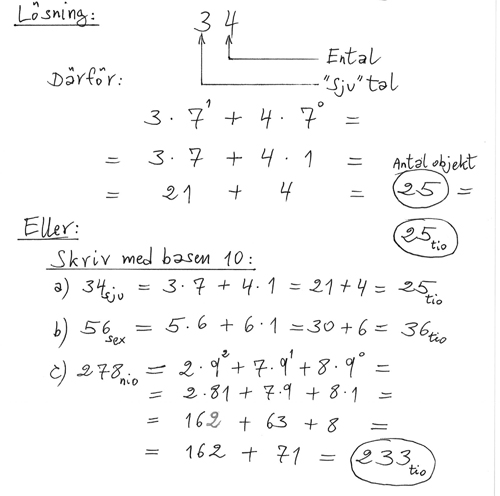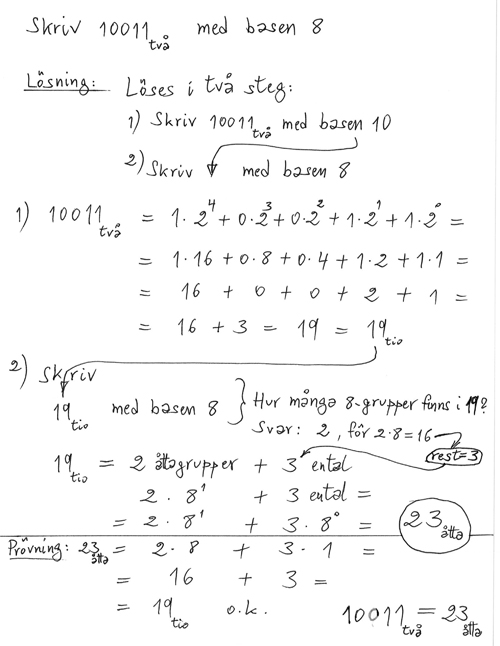Skillnad mellan versioner av "1.8 Talsystem med olika baser"
Från Mathonline
Taifun (Diskussion | bidrag) m |
Taifun (Diskussion | bidrag) m |
||
| Rad 1: | Rad 1: | ||
| + | __NOTOC__ | ||
{| border="0" cellspacing="0" cellpadding="0" height="30" width="100%" | {| border="0" cellspacing="0" cellpadding="0" height="30" width="100%" | ||
| style="border-bottom:1px solid #797979" width="5px" | | | style="border-bottom:1px solid #797979" width="5px" | | ||
| Rad 9: | Rad 10: | ||
| − | + | <big>Om vårt talsystem med basen <math> \, 10 \, </math> se avsnittet [[1.1_Om_tal#Exempel_1|<b><span style="color:blue">Om tal, Exempel 1</span></b>]]<span style="color:black">:</span> <math> \; \boxed{ \; {\color{Red} {7\,142}} \; = \; {\color{Red} 7}\cdot 10\,^3\,+\,{\color{Red} 1}\cdot 10\,^2\,+\,{\color{Red} 4}\cdot 10\,^1\,+\,{\color{Red} 2}\cdot 10\,^0 \; } \; = \; ({\color{Red} {7\,142}})_{\text{tio}} </math> </big> | |
| − | <big>Om vårt talsystem med basen <math> \, 10 \, </math> se avsnittet [[1.1_Om_tal#Exempel_1|<b><span style="color:blue">Om tal, Exempel 1</span></b>]]<span style="color:black">:</span> <math> \ | + | |
| − | :: | + | <big>Samma <span style="color:red">koefficienter</span> i talsystemet med basen <math> \, 8 \, </math> ger ett annat tal<span style="color:black">:</span> <math> \qquad\qquad\quad\;\, {\color{Red} 7} \cdot \;\, 8\,^3\,\,+\,{\color{Red} 1}\cdot \;\, 8\,^2\,+\,{\color{Red} 4}\cdot \;\, 8\,^1\,\,+\,{\color{Red} 2}\cdot \;\, 8\,^0 \;\;\; = \; ({\color{Red} {7\,142}})_{\text{åtta}} \; = \; (3\,682)_{\text{tio}}</math></big> |
| − | == <b><span style="color:#931136"> | + | == <b><span style="color:#931136">Omvandling från basen <math> \, 10 \, </math> till andra baser</span></b> == |
| − | === <b><span style="color:#931136"> | + | === <b><span style="color:#931136">Ex.<span style="color:black">:</span> <math> \;\; </math> Skriv <math> \, 25 \, </math> till andra baser.</span></b> === |
<div style="border:1px solid black;display:inline-table;margin-left: 50px;"> [[Image: Talsystem med olika baser_1_500.jpg]] </div> | <div style="border:1px solid black;display:inline-table;margin-left: 50px;"> [[Image: Talsystem med olika baser_1_500.jpg]] </div> | ||
| − | == <b><span style="color:#931136"> | + | == <b><span style="color:#931136">Omvandling från andra baser till basen <math> \, 10 \, </math>:</span></b> == |
| − | === <b><span style="color:#931136"> | + | === <b><span style="color:#931136">Ex.<span style="color:black">:</span> <math> \;\; </math> Skriv <math> \, \bf{(34)_{sju}} \, </math> till basen <math> \, 10 \, </math>.</span></b> === |
<div style="border:1px solid black;display:inline-table;margin-left: 50px;"> [[Image: Talsystem med olika baser_2_500.jpg]] </div> | <div style="border:1px solid black;display:inline-table;margin-left: 50px;"> [[Image: Talsystem med olika baser_2_500.jpg]] </div> | ||
| Rad 40: | Rad 40: | ||
| − | [[Matte:Copyrights|Copyright]] © 2011- | + | [[Matte:Copyrights|Copyright]] © 2011-2017 Math Online Sweden AB. All Rights Reserved. |
Versionen från 21 augusti 2017 kl. 19.15
| \( \pmb{\gets} \) Förra avsnitt | Genomgång | Övningar | Diagnosprov \( \pmb{\to} \) |
Om vårt talsystem med basen \( \, 10 \, \) se avsnittet Om tal, Exempel 1: \( \; \boxed{ \; {\color{Red} {7\,142}} \; = \; {\color{Red} 7}\cdot 10\,^3\,+\,{\color{Red} 1}\cdot 10\,^2\,+\,{\color{Red} 4}\cdot 10\,^1\,+\,{\color{Red} 2}\cdot 10\,^0 \; } \; = \; ({\color{Red} {7\,142}})_{\text{tio}} \)
Samma koefficienter i talsystemet med basen \( \, 8 \, \) ger ett annat tal: \( \qquad\qquad\quad\;\, {\color{Red} 7} \cdot \;\, 8\,^3\,\,+\,{\color{Red} 1}\cdot \;\, 8\,^2\,+\,{\color{Red} 4}\cdot \;\, 8\,^1\,\,+\,{\color{Red} 2}\cdot \;\, 8\,^0 \;\;\; = \; ({\color{Red} {7\,142}})_{\text{åtta}} \; = \; (3\,682)_{\text{tio}}\)
Omvandling från basen \( \, 10 \, \) till andra baser
Ex.: \( \;\; \) Skriv \( \, 25 \, \) till andra baser.
Omvandling från andra baser till basen \( \, 10 \, \):
Ex.: \( \;\; \) Skriv \( \, \bf{(34)_{sju}} \, \) till basen \( \, 10 \, \).
Omvandling mellan olika baser
Copyright © 2011-2017 Math Online Sweden AB. All Rights Reserved.


